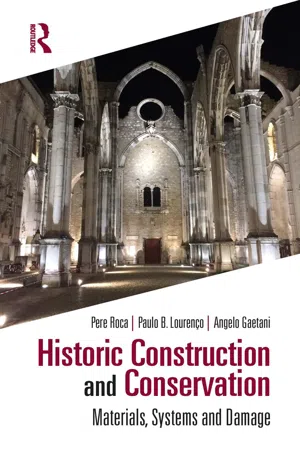
Historic Construction and Conservation
Materials, Systems and Damage
- 324 pages
- English
- ePUB (mobile friendly)
- Available on iOS & Android
Historic Construction and Conservation
Materials, Systems and Damage
About This Book
Conservation in the built environment raises fundamental questions which have been debated for centuries - what is worth preserving, how is it possible, why is it important?
This book takes a modern approach to the meaning of a heritage structure and its conservation. The historical evolution of conservation is briefly addressed, considering prominent individuals and cases; along with the history of construction, focusing on materials and related structural elements, with insight on the sizing rules adopted by masons. This explains structural decisions made during the construction process and allows comparison of scientific theories from the 18th century to modern understanding of limit analysis. Damage and collapse mechanisms for masonry construction, as the most widespread structural form for historical buildings, is described. Excess permanent loading and settlement is differentiated from environmental and anthropogenic actions such as earthquake or incorrect intervention.
The team of authors brings together unique expertise, with high level research and leading practice with archetypical cases from around the world. The book addresses the history of conservation by exploring materials and structures and the history of construction and damage, so it is of value to students and professionals in civil engineering and architecture, as well as archaeologists and art historians.
Frequently asked questions
Information
Chapter 1
Modern understanding of conservation and of heritage structures
1.1 DEFINITION OF BUILT CULTURAL HERITAGE AND CONSERVATION
- monuments: architectural works, works of monumental sculpture and painting, elements or structures of an archaeological nature, inscriptions, cave dwellings and combinations of features, which are of outstanding universal value from the point of view of history, art or science (Figure 1.1a);
- groups of buildings: groups of separate or connected buildings which, because of their architecture, their homogeneity or their place in the landscape, are of outstanding universal value from the point of view of history, art or science (Figure 1.1b);
- sites: works of man or the combined works of nature and man, and areas including archaeological sites which are of outstanding universal value from the historical, aesthetic, ethnological or anthropological point of view (Figure 1.1c).


- Nara Charter, all efforts designed to understand cultural heritage, know its history and meaning, ensure its material safeguard and, as required, its presentation, restoration and enhancement (ICOMOS, 1994);
- International Organization for Standardization, all actions or processes that are aimed at safeguarding the character-defining elements of a cultural resource so as to retain its heritage value and extend its physical life (ISO 13822:2010, Annex I on Heritage Structures.
- Preservation: action or process of protecting, maintaining and/or stabilizing the existing materials, form and integrity of a cultural resource or of an individual component, while protecting its heritage value. Note that preservation is much used in American English, while conservation is much used in European English for the same concept. In Europe, preservation is used more in the context of materials or conservators (such as stone, paper, textiles, paintings, sculptures and alike), whereas conservation is almost exclusively used for the built cultural heritage;
- Restoration: action or process of accurately revealing, recovering or representing the state of a cultural resource or of an individual component, as it appeared in a particular period of its history, while protecting its heritage value.
1.2 CULTURAL ...
Table of contents
- Cover
- Half Title
- Title Page
- Copyright Page
- Table of Contents
- List of Figures
- List of Tables
- Preface
- Foreword
- 1 Modern understanding of conservation and of heritage structures
- 2 History of conservation
- 3 Construction materials and main structural elements
- 4 Vaulted structures in history and modern structural solutions
- 5 Ancient sizing rules and limit analysis of masonry arches
- 6 Damage and collapse mechanisms in masonry buildings
- Conclusions
- Bibliography
- Permissions
- Index
- Index of Monuments
- Index of Scholars